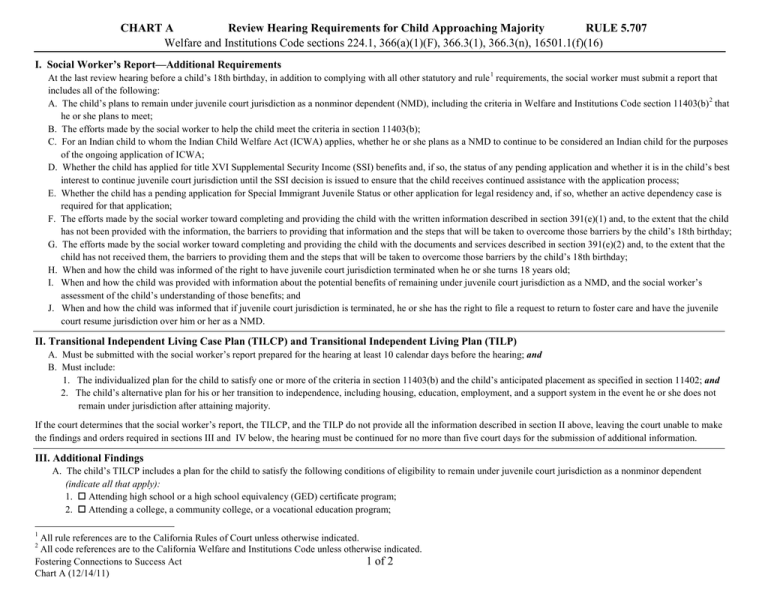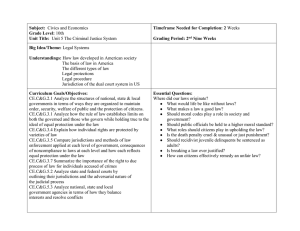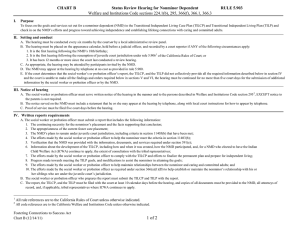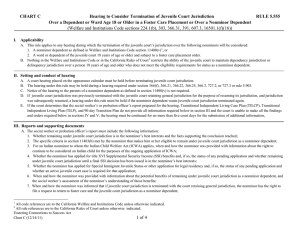CHART A ... RULE 5.707
advertisement

CHART A Review Hearing Requirements for Child Approaching Majority RULE 5.707 Welfare and Institutions Code sections 224.1, 366(a)(1)(F), 366.3(1), 366.3(n), 16501.1(f)(16) I. Social Worker’s Report—Additional Requirements At the last review hearing before a child’s 18th birthday, in addition to complying with all other statutory and rule 1 requirements, the social worker must submit a report that includes all of the following: A. The child’s plans to remain under juvenile court jurisdiction as a nonminor dependent (NMD), including the criteria in Welfare and Institutions Code section 11403(b) 2 that he or she plans to meet; B. The efforts made by the social worker to help the child meet the criteria in section 11403(b); C. For an Indian child to whom the Indian Child Welfare Act (ICWA) applies, whether he or she plans as a NMD to continue to be considered an Indian child for the purposes of the ongoing application of ICWA; D. Whether the child has applied for title XVI Supplemental Security Income (SSI) benefits and, if so, the status of any pending application and whether it is in the child’s best interest to continue juvenile court jurisdiction until the SSI decision is issued to ensure that the child receives continued assistance with the application process; E. Whether the child has a pending application for Special Immigrant Juvenile Status or other application for legal residency and, if so, whether an active dependency case is required for that application; F. The efforts made by the social worker toward completing and providing the child with the written information described in section 391(e)(1) and, to the extent that the child has not been provided with the information, the barriers to providing that information and the steps that will be taken to overcome those barriers by the child’s 18th birthday; G. The efforts made by the social worker toward completing and providing the child with the documents and services described in section 391(e)(2) and, to the extent that the child has not received them, the barriers to providing them and the steps that will be taken to overcome those barriers by the child’s 18th birthday; H. When and how the child was informed of the right to have juvenile court jurisdiction terminated when he or she turns 18 years old; I. When and how the child was provided with information about the potential benefits of remaining under juvenile court jurisdiction as a NMD, and the social worker’s assessment of the child’s understanding of those benefits; and J. When and how the child was informed that if juvenile court jurisdiction is terminated, he or she has the right to file a request to return to foster care and have the juvenile court resume jurisdiction over him or her as a NMD. II. Transitional Independent Living Case Plan (TILCP) and Transitional Independent Living Plan (TILP) A. Must be submitted with the social worker’s report prepared for the hearing at least 10 calendar days before the hearing; and B. Must include: 1. The individualized plan for the child to satisfy one or more of the criteria in section 11403(b) and the child’s anticipated placement as specified in section 11402; and 2. The child’s alternative plan for his or her transition to independence, including housing, education, employment, and a support system in the event he or she does not remain under jurisdiction after attaining majority. If the court determines that the social worker’s report, the TILCP, and the TILP do not provide all the information described in section II above, leaving the court unable to make the findings and orders required in sections III and IV below, the hearing must be continued for no more than five court days for the submission of additional information. III. Additional Findings A. The child’s TILCP includes a plan for the child to satisfy the following conditions of eligibility to remain under juvenile court jurisdiction as a nonminor dependent (indicate all that apply): 1. Attending high school or a high school equivalency (GED) certificate program; 2. Attending a college, a community college, or a vocational education program; 1 All rule references are to the California Rules of Court unless otherwise indicated. All code references are to the California Welfare and Institutions Code unless otherwise indicated. Fostering Connections to Success Act 1 of 2 Chart A (12/14/11) 2 CHART A Review Hearing Requirements for Child Approaching Majority RULE 5.707 Welfare and Institutions Code sections 224.1, 366(a)(1)(F), 366.3(1), 366.3(n), 16501.1(f)(16) 3. Participating in a program or activities to promote employment or to overcome barriers to employment; 4 . Being employed at least 80 hours per month; 5. Having a medical condition that makes the child unable to attend a high school, GED program, college, community college, vocational education program, or a program or activities to promote employment or overcome barriers to employment, or to work 80 hours per month; B. The child’s TILCP includes an alternative plan for the child’s transition to independence, including housing, educations, employment, and a support system in the event the child does not remain under juvenile court jurisdiction after attaining 18 years of age; C. For a child who has an in-progress application pending for title XVI Supplemental Security Income (SSI) benefits, continuation of juvenile court jurisdiction to ensure continued assistance with the application process until a final SSI decision is issued is is not in the child’s best interest; D. For a child who has an in-progress application pending for Special Immigrant Juvenile Status or other legal residency application, an active juvenile court case is is not required for that application. E. The child has been informed that on turning 18, he or she has the right to have juvenile court jurisdiction terminated after a hearing under rule 5.555. F. The potential benefits of remaining under juvenile court jurisdiction as a NMD were explained to the child and the child has stated that he or she those benefits. G. The child has been informed that if juvenile court jurisdiction is terminated, he or she has the right to file a request to return to foster care and have the court resume jurisdiction over him or her as a NMD. H. Information, Documents, and Services 1. All the information, documents and services in section 391(e) have been provided to the child; or 2. Not all the information, documents and services in section 391(e) have been provided to the child, and the barriers to providing any missing information, documents, or services can be overcome by the child’s 18th birthday; or 3. Not all the information, documents, and services in section 391(e) have been provided to the child and the barriers to providing any missing information, documents, or services cannot be overcome by the child’s 18th birthday. Juvenile court jurisdiction must be continued to ensure that all required information, documents, and services are provided to the child. I. For a child to whom the Indian Child Welfare Act applies: 1. The child intends to continue to be considered an Indian child for purposes of the ongoing application of ICWA to the child as a NMD; or 2. The child does not intend to continue to be considered an Indian child for purposes of the ongoing application of ICWA to the child as a NMD. IV. Orders A. For a child who INTENDS TO REMAIN under juvenile court jurisdiction as a nonminor dependent after age 18, a review hearing under rule 5.903 is set on (choose date within next six months): __/__/__ ; or B. For a child who DOES NOT INTEND TO REMAIN under juvenile court jurisdiction as a nonminor dependent after age 18, a hearing under rule 5.555 is set on (choose a date within one month after child’s 18th birthday): __/__/__ ; or C. For a child who WILL REMAIN under juvenile court jurisdiction in a foster care placement after age 18 but is not eligible for nonminor dependent status, a hearing under section 366.21, 366.22, 366.25, or 366.3 is set on (choose date within next six months): __/__/__ . The information on this chart is based on the provisions of Assembly Bill 12 (Beall; Stats. 2010, ch. 559), the California Fostering Connections to Success Act, as amended by Assembly Bill 212 (Beall; Stats. 2011, ch. 459) and the California Rules of Court, effective January 1, 2012. The chart was compiled by the Juvenile Court Assistance Team, Center for Families, Children & the Courts, Administrative Office of the Courts, 455 Golden Gate Avenue, San Francisco, California 94102-3688, 415-865-7739, cfcc@jud.ca.gov Fostering Connections to Success Act Chart A (12/14/11) 2 of 2




